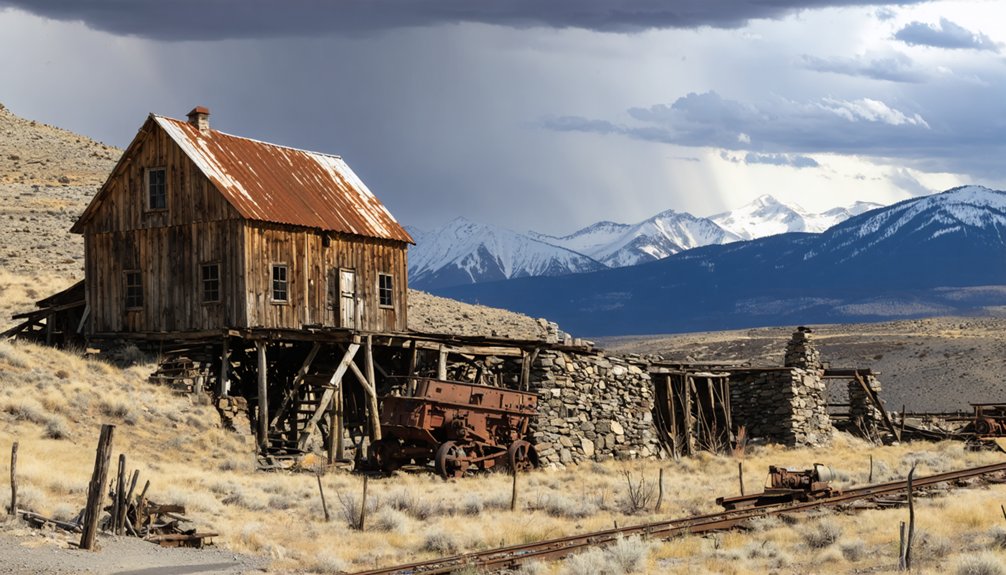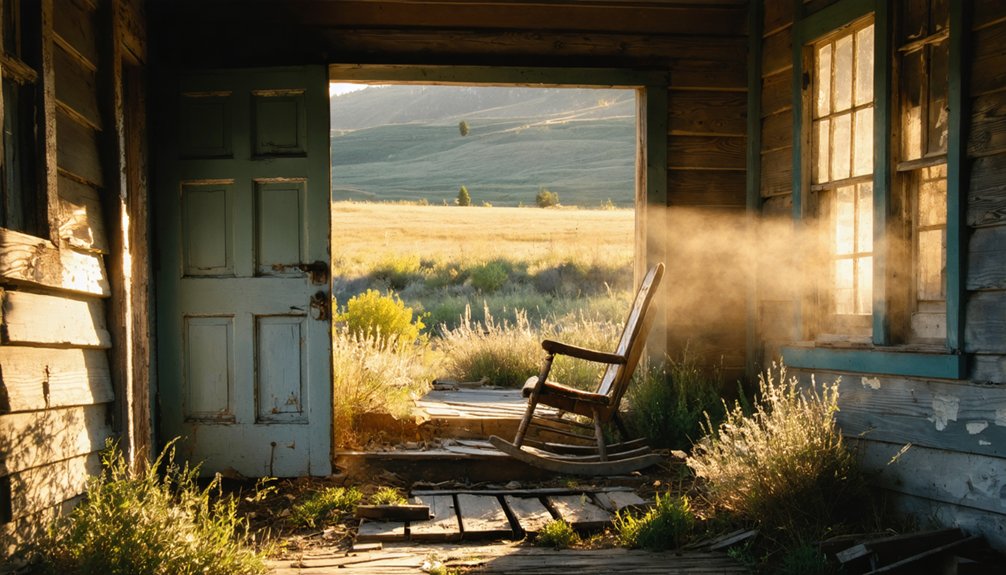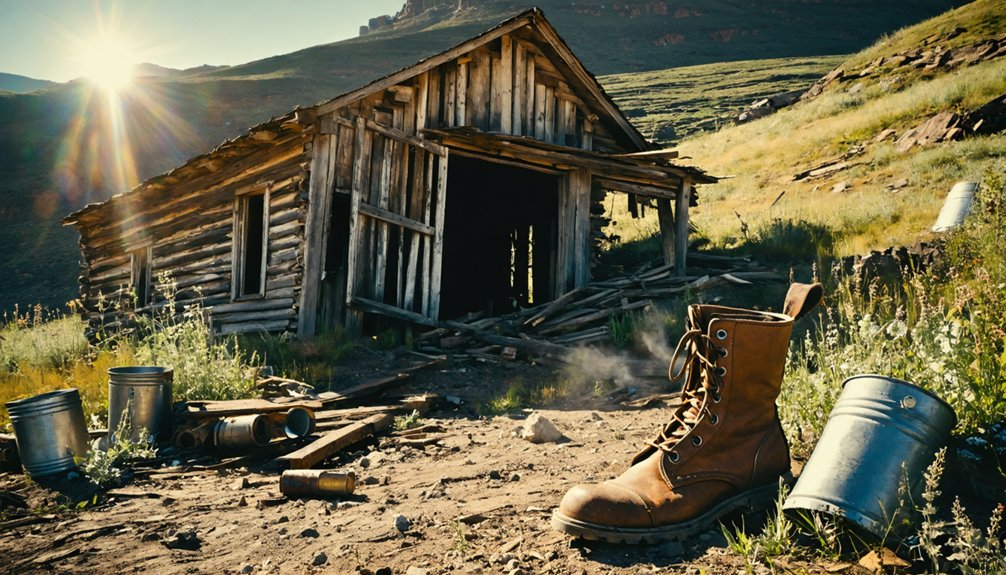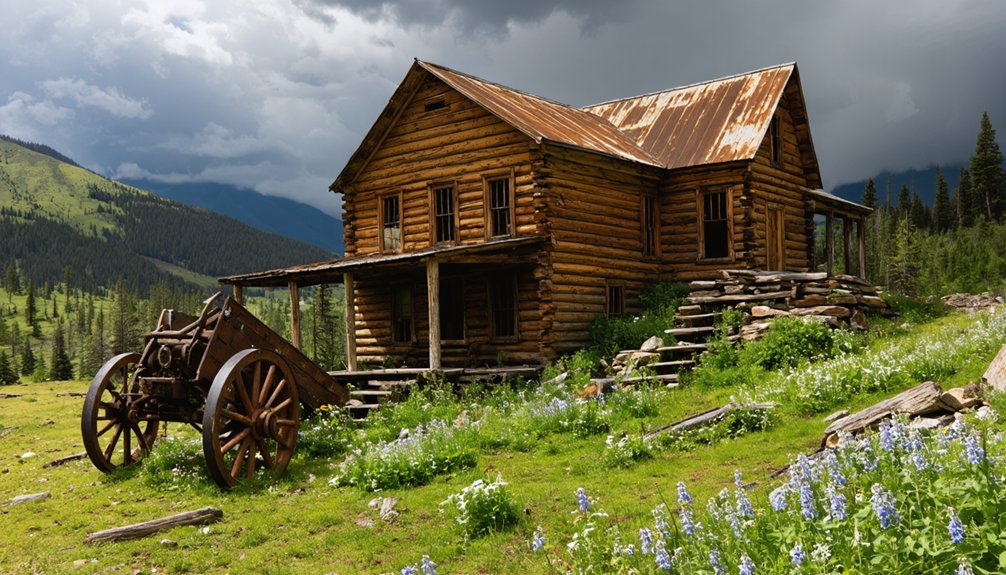You’ll find the Comeback Mine perched at 5,300 feet in Idaho’s Grimes Pass District, where it operated from 1920 as a rich silver, zinc, and lead producer. The mine achieved remarkable grades of 95.39 ounces of silver per ton, employing over 80 men in its heyday. Today, this ghost town‘s abandoned structures and mining remnants tell stories of harsh mountain living, challenging operations, and the boom-bust cycle that shaped Idaho’s mining frontier.
Key Takeaways
- The Comeback Mine, discovered in 1920 in Boise County’s Grimes Pass District, was a major producer of silver, zinc, and lead.
- Located at 5,300 feet elevation, the mining camp featured simple dwellings and harsh living conditions for its transient worker population.
- Mining operations included underground extraction of precious metals, using drilling and blasting techniques while battling seasonal weather challenges.
- The camp’s decline stemmed from depleting ore grades, unstable metal prices, and rising operational costs, particularly after 1959.
- The abandoned site now serves as a historical landmark of Idaho’s mining era, preserving evidence of its sawmills and mining infrastructure.
The Rise of a Mining Frontier

When prospectors discovered the Comeback Mine in 1920 in Boise County’s Grimes Pass District, they’d stumbled upon what would become a significant producer of silver, zinc, and lead.
You’ll find this mining boom site perched at 5,801 feet, where frontier life took hold as the Comeback Mining Co. developed the underground operation. Like the later Meadow Creek Mine that operated with over 80 men, the Comeback became a hub of mining activity.
The mine achieved impressive production grades, yielding ore containing 95.39 ounces per ton of silver during its operations.
Life in the Mountain Camp
Despite the harsh mountain conditions at over 5,300 feet elevation, miners carved out a rugged existence at the Comeback Mine Camp during the 1920s. You’d have found these hardy souls living in simple dwellings near the mine entrance, their daily routines dictated by the demanding schedule of underground work and ore extraction.
Life wasn’t easy in this remote Idaho camp. You’d face seasonal challenges as winter storms swept through the mountains, while summer brought its own set of difficulties. The small deposit size meant limited opportunities for long-term prosperity. The workers spent long hours in the four separate tunnels that stretched deep into the mountainside.
The miners’ world revolved around shift work, blasting schedules, and the constant movement of extracted ore. Without permanent families or established community structures, the camp maintained a transient atmosphere.
You wouldn’t find churches, schools, or organized recreation here – just the raw pursuit of gold and other precious metals in this untamed frontier setting.
Mining Operations and Methods
In the steep terrain of Boise County’s Comeback Mine, you’d find miners extracting gold along with copper, lead, zinc, and silver through underground operations.
Modern mining advocates like McKinsey Lyon emphasize the need for responsible mining practices while honoring Idaho’s mining heritage.
You can imagine the challenging work conditions as teams of miners navigated the complex geology of the Rocky Mountain system.
While specific equipment details aren’t documented, you’ll know the operation had to comply with the mining regulations of the era, managing ore extraction and transport through the mountainous landscape.
Legal disputes over mining claims were common, as seen in the historic case where Judge Richards dismissed LeVan’s competing claim against Plowman without requiring defense testimony.
Mining Equipment and Techniques
At the Comeback Mine, underground operations dominated the extraction process for gold, copper, lead, zinc, and silver deposits during its peak production years from 1928 through the 1940s.
You’ll find that traditional underground techniques were essential to accessing the valuable ore bodies, with miners relying on drilling and blasting to create tunnels and shafts for ore extraction. Early miners from gold rush California brought their expertise to the region, helping establish effective mining practices.
While specific equipment details haven’t survived in historical records, you’d have seen typical underground mining tools of the era, including drills, loaders, and ore haulers moving through the mine’s network of tunnels.
The operation required careful geological analysis to track viable veins, alongside robust ventilation systems and safety measures to protect the miners working below ground.
These methods proved successful, leading to significant production, particularly in 1943.
Ore Processing and Transport
Once extracted from underground, the ore from Comeback Mine underwent extensive processing to separate valuable minerals from waste rock.
You’d find stamp mills crushing the ore for liberation, followed by wet grinding to create a mineral-rich slurry. The ground ore moved through the camp via rail cars, conveyors, and water-based transport systems to reach processing facilities.
For recovery, workers used mercury amalgamation for free-milling gold, while silver and lead ores required more complex methods like the Washoe process or flotation cells.
After 1920, flotation became the preferred concentration method. Tailings management involved careful disposal of waste in designated ponds, with systems for water recycling and acid drainage control.
The operation’s efficiency depended on well-coordinated transport between underground workings, processing plants, and waste facilities.
Geographic Features and Location
Nestled within Boise County‘s rugged terrain, Comeback Mining Camp sits at elevations ranging from 5,361 to 5,801 feet above sea level near the historic town of Placerville.
You’ll find the camp within the Grimes Pass Mining District, surrounded by the pristine wilderness of Boise National Forest.
The site presents significant topographical challenges, with steep slopes and rocky outcrops dominating the landscape.
Complex geological formations, typical of Idaho’s gold belt, feature lode deposits and mineral-rich veins running through hard rock.
Hidden within Idaho’s gold belt, rich mineral veins slice through ancient bedrock, creating the complex geology miners sought to conquer.
The area spans 20.66 acres of mineral-rich terrain that has attracted mining interests for generations.
You’ll encounter a network of streams and seasonal creeks that once supported mining operations, while dense pine and fir forests blanket the mountainous surroundings.
Like many sites in the region marked by red locality icons, the camp’s precise coordinates have been documented in mining records.
Access requires navigation of rugged forest roads, making the site particularly challenging during winter months.
The Path to Abandonment

You’ll find that Comeback Mining Camp‘s decline primarily stemmed from depleting ore grades and unstable metal prices, with cobalt production falling sharply after 1959 despite earlier success that yielded over 14 million pounds.
The area’s mining challenges mirrored those faced by pioneers like Al Hennessey’s operations which had previously struggled with similar market volatility and resource depletion.
Your trek through the camp’s history shows how rising operational costs and processing challenges made continued mining unprofitable, even as brief market upswings in 1967 and 1980-82 sparked unsuccessful revival attempts.
The camp’s workforce steadily diminished as economic pressures mounted, leaving behind abandoned infrastructure that stands as evidence to the boom-and-bust cycle common in Idaho’s mining districts.
Economic Forces Behind Decline
The economic decline of Comeback Mining Camp stemmed from a complex web of market forces that gradually choked its viability in the mid-20th century.
You’ll find that market volatility, particularly in cobalt and copper prices after 1959, dealt a devastating economic impact to the region’s mining operations.
The camp’s fate was sealed by three critical factors:
- Exhaustion of high-grade ore deposits forced costly deep mining ventures
- External financial control by Eastern investors drained profits from the local economy
- Geographic isolation and poor infrastructure limited economic diversification
You couldn’t sustain a mining town when the richer deposits were gone and transportation costs ate into profits.
Without a diversified economic base, Comeback Mining Camp couldn’t weather the storm when mineral prices plummeted and outside investors pulled their capital.
Hard Mining Conditions Persist
Multiple challenges plagued underground mining operations at Comeback Mine, where workers battled harsh geological conditions in the Northern Rocky Mountains.
You’d find miners struggling with complex polymetallic ore bodies that required extensive tunneling through hard rock formations, demanding both physical labor and technical expertise to prevent cave-ins.
Water scarcity proved a persistent headache, especially during dry seasons when you couldn’t process ore effectively.
The mine’s remote location meant you’d face unreliable water supplies for essential operations like sluicing and ore washing.
Spring snowmelt would flood the tunnels, while summer drought brought work to a standstill.
These geological challenges, combined with primitive technology and inadequate infrastructure, meant you’d constantly battle nature just to keep the operation running.
Manual drilling and mechanical processing left many mineral-rich zones untapped, ultimately contributing to the mine’s decline.
Population Gradually Drifts Away
As rich gold strikes at Comeback Mining Camp began dwindling in the late 1800s, populations steadily trickled away from this remote Bitterroot Range settlement. The demographic changes you’d witness during this period revealed a stark transformation of the once-bustling mining community.
- First-wave European miners departed as shallow placer deposits ran dry, leaving Chinese and Kanaka miners to work the remaining claims.
- Community fragmentation accelerated as stores, churches, and schools shuttered their doors.
- Younger residents left for urban opportunities, while harsh winters and disease took their toll on those who stayed.
You’ll find that isolation within the upper tributaries of the North Clearwater didn’t help matters. Limited transportation, scarce supplies, and minimal medical care made life increasingly difficult, pushing even the most determined settlers toward more hospitable locations.
Legacy and Historical Significance

Mining camps like Comeback stand as poignant reminders of Idaho’s dynamic gold rush era, serving both as cultural heritage sites and cautionary tales of boom-and-bust economics.
When you visit today, you’ll find a place that tells the story of Idaho’s ambitious prospectors, diverse immigrant populations, and the relentless pursuit of mineral wealth that shaped the region’s development.
While time has taken its toll, historical preservation efforts aim to protect what remains of these vulnerable sites from vandalism and souvenir hunting.
You can still spot evidence of the sawmills, quartz mills, and basic amenities that once supported the mining community.
These fragments of the past don’t just represent abandoned dreams – they’re valuable educational resources that help you understand how mining camps contributed to Idaho’s economic growth and social fabric.
Frequently Asked Questions
Are There Any Surviving Artifacts From the Camp Available in Museums?
You won’t find verified artifacts from the camp in museums. While Idaho’s mining history preservation efforts are extensive, there’s no documented proof that any surviving items came specifically from this site.
What Wildlife Species Commonly Inhabit the Abandoned Camp Site Today?
You’ll spot mule deer, elk, and coyotes regularly at the site, while black bears occasionally visit. Wildlife observations reveal abundant small mammals, sage grouse, hawks, rattlesnakes, and native species throughout the area.
Can Visitors Legally Collect Mineral Specimens From the Area?
While mineral collecting tempts many freedom-loving rockhounds, you can’t legally gather specimens here without the private property owner’s explicit permission. Public land collecting requires specific permits and permissions.
Were Any Notable Crimes or Conflicts Recorded at Comeback Mining Camp?
You won’t find specific records of notable crimes or mining disputes at Comeback Camp, though it likely experienced similar historical incidents to other remote Idaho mining areas during that turbulent era.
Does the Site Have Any Paranormal Activity Reports or Ghost Stories?
While ghost sightings and eerie encounters echo through many Idaho mining camps, you won’t find documented paranormal reports from Comeback Mining Camp, though its lonely mountain setting fuels local whispers.
References
- https://thediggings.com/mines/22833
- https://westernmininghistory.com/mine-detail/10090093/
- https://www.lib.uidaho.edu/digital/context/items/context_86.html
- https://yellowpinetimes.wordpress.com/2023/04/09/idaho-history-apr-9-2023/
- https://westernmininghistory.com/mine-detail/10120021/
- https://idgenweb.org/archives/history-ghost+towns.html
- https://www.idahogeology.org/pub/Bulletins/B-22.pdf
- https://caspercollege.cvlcollections.org/items/show/9865
- https://www.boisecounty.us/visit-boise-county/
- https://objects.lib.uidaho.edu/taylorarchive/b4-HistoricalAccounts-008.pdf



